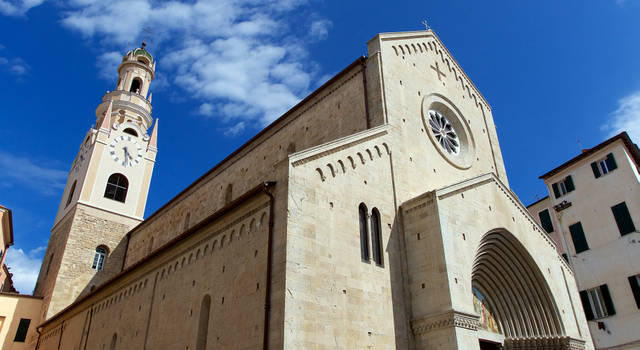San Siro Church , also named Insigne Basilica Collegiata Cattedrale of San Siro, is the oldest area of worship in Sanremo. The church, prototype of Roman church, was built in the 12th century (perhaps by the Masters Comacini) on the remains of a tiny early Christian church , dated to 811, where Bishop Siro used to celebrate the holy Mass.
The structure is formed by a parallelogram of three naves, with a double order of columns and all round acute arches. Even if the interior appears romanic , there are a gothic elements, like the capitals, the ogival arches and the partial use of black stone blocks .
The church is the product of a long reconstruction of the protoromanic structure; in the Baroque important alterations were made because of stability problems.
In 20th century the Baroque overlays were deleted with the restoration work in order to recuperate the original elements, to restore the church’s medieval shape.
The bas-relief of the left side door dates back to the primitive period of the church, expression of the feelings of the Christian images, inspired by mildness and love. On the other side, the bas-relief (dating back to the 17th century) represents the Virgin with the baby on her womb: at her sides there are Siro and Romolo, wearing pastoral Mitras and the Dragon’s attributes, the Book and the Sword. Inside the church, really interesting is a black crucifix in the right nave, protector of sailors and support of the sanremasca community during calamities, the tabernacle in the altar of the Blessed Sacrament, bas-relief carved in the Renaissance age on a marble slab walled up at 1,40 metres from the floor, and the choir table, dating back to the 16th century that portrays San Siro, Pietro and Paolo at his left and Giovanni Battista and Romolo at his right. The crucifix of the major altar and the statue of the Madonna of the Rosary are artistically and historically important, and they are both by Anton Maria Maragliano. The bell tower was rebuilt in Baroque style in 1948.
San Siro’s Treasure includes silver precious objects of genoese school, like missals, basins, ostensories and chalices, dating back to the 16th and the 19th centuries and numerous sacred vestments, while the parish archive contains a lot of notes about the city’s historical events.
The Maestri Comacini were architects, bricklayers, decorators and artists, grouped in a corporation of itinerant construction companies, working since the end of the 7th century, composed by specialized professionals from Lombardia. These skilled workers were the only ones to know the roman constructive techniques, lost with the fall of the Empire, so they created a new art, the high medieval Romanesque art.
Maestri Comacini were all anounimous because they gave importance to the group.
The black crucifix is of an unknown worker, probably in the 15th century; a miracolous event is related to it. The 7 August 1543, the news of a new Saracen raids came to Sanremo. In the middle of a propitiatory mass right before the battle, the Christ, radiating light, turned smiling towards the mayor Luca Spinola. Later, the city militia, guided by Spinola himself, won against the Saracens ,near Verezzo (Battaglia della Parà). According to some sources that same crucifix was brought in the battle as a ensign.

